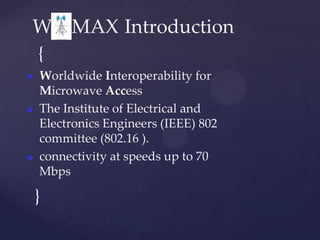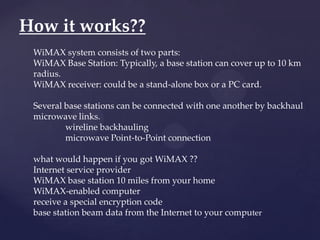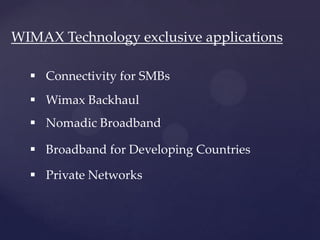introduction to wimax
- 1. Implementation of WIMAX base station { By D.Swathi G.Kranthi reddy B.Jagadeeswara reddy } Teegala krishna reddy engineering college
- 2. Telecommunications ï§ Tele (Far) + Communications ï§ Early telecommunications smoke signals and drums visual telegraphy (or semaphore in 1792) ï§ Telegraph and telephone Telegraph (1839) Telephone (1876) ï§ Radio and television ï§ Telephony Voice and Data
- 3. 80wifi PAN LAN MAN WAN RAN Wimax IEEE 802.11 Uwb, bluetooth 3gpp , 3gpp2 IEEE 802.22 IEEE 802.20 IEEE 802.16e IEEE 802.16 wifi IEEE 802.15.3 TELECOM NETWORKS
- 4. W MAX Introduction { ïŪ Worldwide Interoperability for Microwave Access ïŪ The Institute of Electrical and Electronics Engineers (IEEE) 802 committee (802.16 ). ïŪ connectivity at speeds up to 70 Mbps }
- 6. How it works?? WiMAX system consists of two parts: WiMAX Base Station: Typically, a base station can cover up to 10 km radius. WiMAX receiver: could be a stand-alone box or a PC card. Several base stations can be connected with one another by backhaul microwave links. wireline backhauling microwave Point-to-Point connection what would happen if you got WiMAX ?? Internet service provider WiMAX base station 10 miles from your home WiMAX-enabled computer receive a special encryption code base station beam data from the Internet to your computer
- 7. WIMAX is a technology based on the IEEE 802.16 specifications to enable the delivery of last-mile wireless broadband access as an alternative to cable and DSL. The design of WIMAX network is based on the following major principles: ï§ Spectrum ï§ Topology ï§ Interworking ï§ IP connectivity
- 8. SAILENT FEATURES OF WIMAX ï§ Line-of-sight and Non line-of-sight ï§ Support for TDD and FDD ï§ WIMAX uses OFDM ï§ Robust security ï§ IP-based architecture ï§ Support for advanced antenna techniques ï§ Adaptive modulation and coding (AMC)
- 9. WIMAX Technology exclusive applications ï§ Wimax Backhaul ï§ Nomadic Broadband ï§ Broadband for Developing Countries ï§ Private Networks ï§ Connectivity for SMBs
- 10. THANK YOU










